Photograph by Ing-On Vibulbhan-Watts
I went to Thailand to visit my family for two months, from July and August 2017. I did not visit home since 2006. I was glad to see my family. I enjoyed seeing all new development in Bangkok and loved eating authentic Thai food, especially Thai fruits.
I had a chance to visit my home town, Lopburi, where I was raised when I was young, before we moved to Bangkok. I traveled to Ayutthaya to see the ruins of temples that were burned by Burmese soldiers, when the Burmese wanted to take over Thailand, The Burmese–Siamese War (1765–1767). Ayutthaya was one of the former capitals of Thailand before moved to, Thonburi and then Bangkok. I also traveled to, Chiang Mai, located in the Northern part of Thailand. Chiang Mai is the second largest and second most popular city of Thailand.
John, my husband came to Thailand in August. He joined me traveling to different part of Thailand. I had a good time taking videos and photographs wherever I traveled around Bangkok and other part of Thailand. I hope the viewers of my website will enjoy the photographs that I present in these projects.
Ing-On Vibulbhan-Watts, Thursday, October 26, 2017
The Thai Classical dancers perform for Pra Phrom (The four-faced Brahma God) at the Erawan Shrine, Bangkok, Thailand
Photograph by Ing-On Vibulbhan-Watts
Thailand’s culture has evolved greatly over time, from the country’s pre-globalization time in Sukhothai era, to its more contemporary Ayutthaya era, which absorbs influences from all over Asia. Strong Indian, Chinese and other Southeast Asian influences are still evident in traditional Thai culture up until the modern Rattanakosin era.[1] Buddhism and Animism also play a significant role in shaping the culture.
For more information please visit the following link:
https://en.wikipedia.org/wiki/Culture_of_Thailand
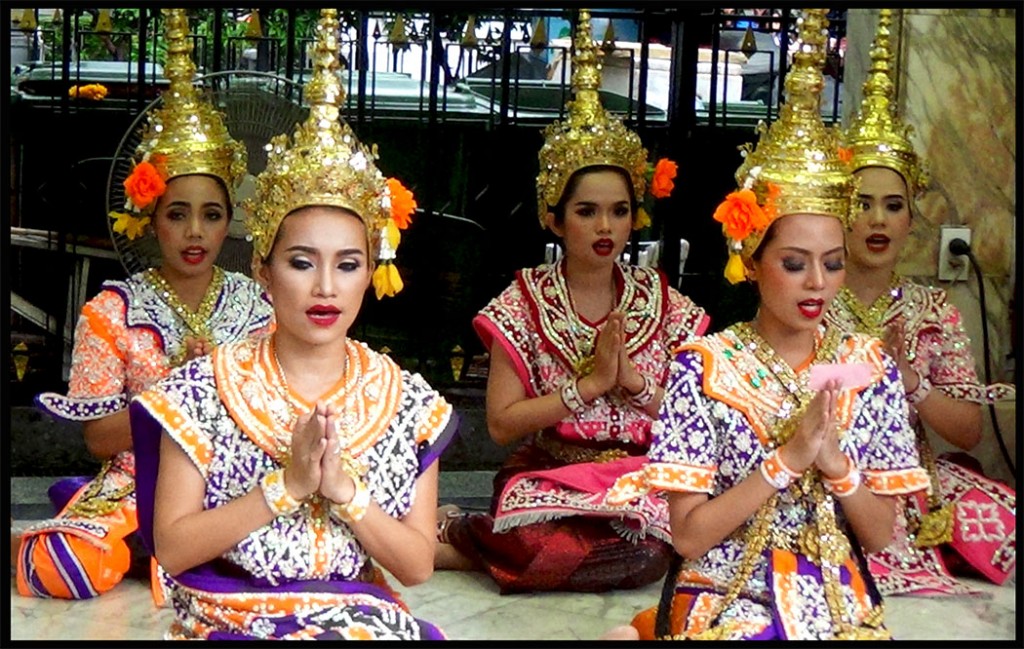 Thailand is nearly 94 percent Buddhist, mainly of the Theravada school (which includes the Thai Forest Tradition and the Dhammayuttika Nikaya and Santi Asoke sects) and an unknown minority belonging to the Mahayana school. In addition there are minorities of Muslims in Thailand (5-6 percent), Christians (1 percent), and other religions.[2] Thai Theravada Buddhism is supported and overseen by the government, with monks receiving a number of government benefits, such as free use of public transportation.
Thailand is nearly 94 percent Buddhist, mainly of the Theravada school (which includes the Thai Forest Tradition and the Dhammayuttika Nikaya and Santi Asoke sects) and an unknown minority belonging to the Mahayana school. In addition there are minorities of Muslims in Thailand (5-6 percent), Christians (1 percent), and other religions.[2] Thai Theravada Buddhism is supported and overseen by the government, with monks receiving a number of government benefits, such as free use of public transportation.
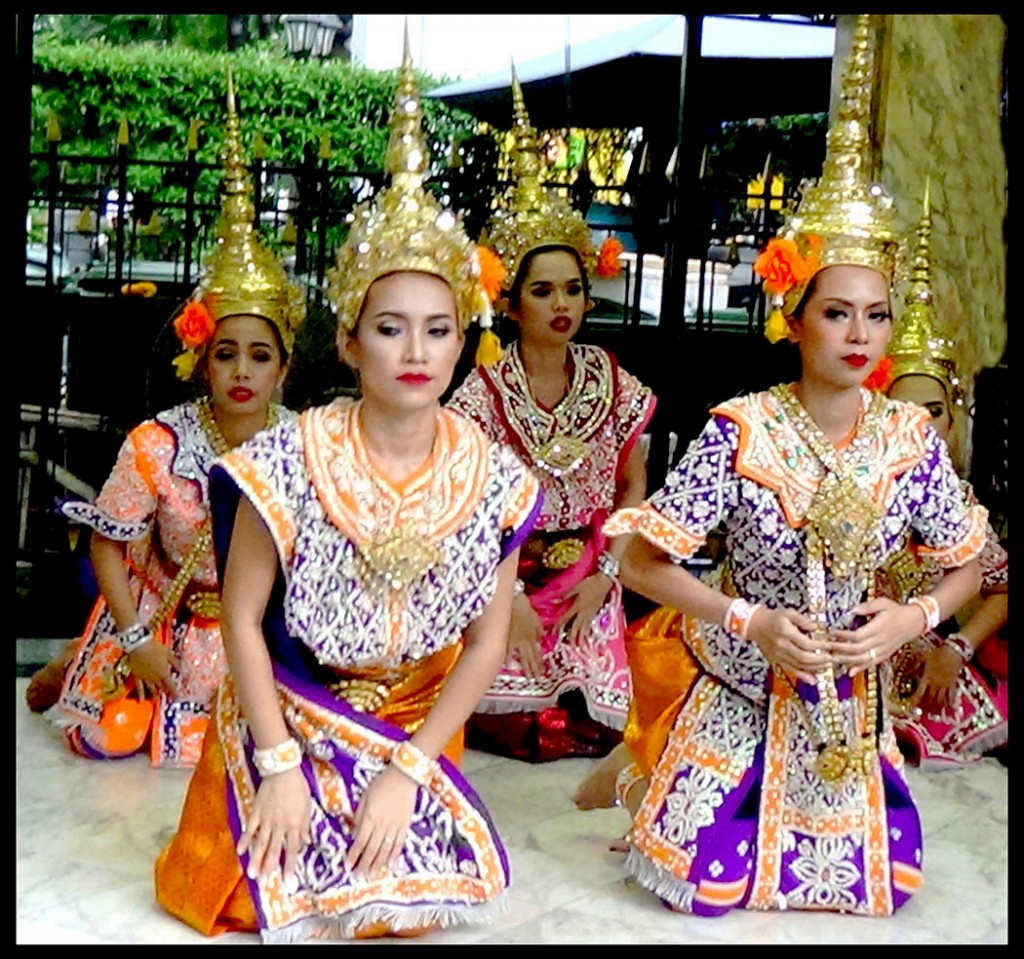 Buddhism in Thailand is strongly influenced by traditional beliefs regarding ancestral and natural spirits, which have been incorporated into Buddhist cosmology. Most Thai people install spirit houses (Thai: ??????????; rtgs: san phra phum), miniature houses outside their dwellings, where they believe household spirits live. They present offerings of food and drink to these spirits to keep them happy. If these spirits aren’t happy, it is believed that they will inhabit the household and cause chaos. These spirit houses can be found in public places and on the streets of Thailand, where the public make offerings.[3]
Buddhism in Thailand is strongly influenced by traditional beliefs regarding ancestral and natural spirits, which have been incorporated into Buddhist cosmology. Most Thai people install spirit houses (Thai: ??????????; rtgs: san phra phum), miniature houses outside their dwellings, where they believe household spirits live. They present offerings of food and drink to these spirits to keep them happy. If these spirits aren’t happy, it is believed that they will inhabit the household and cause chaos. These spirit houses can be found in public places and on the streets of Thailand, where the public make offerings.[3]
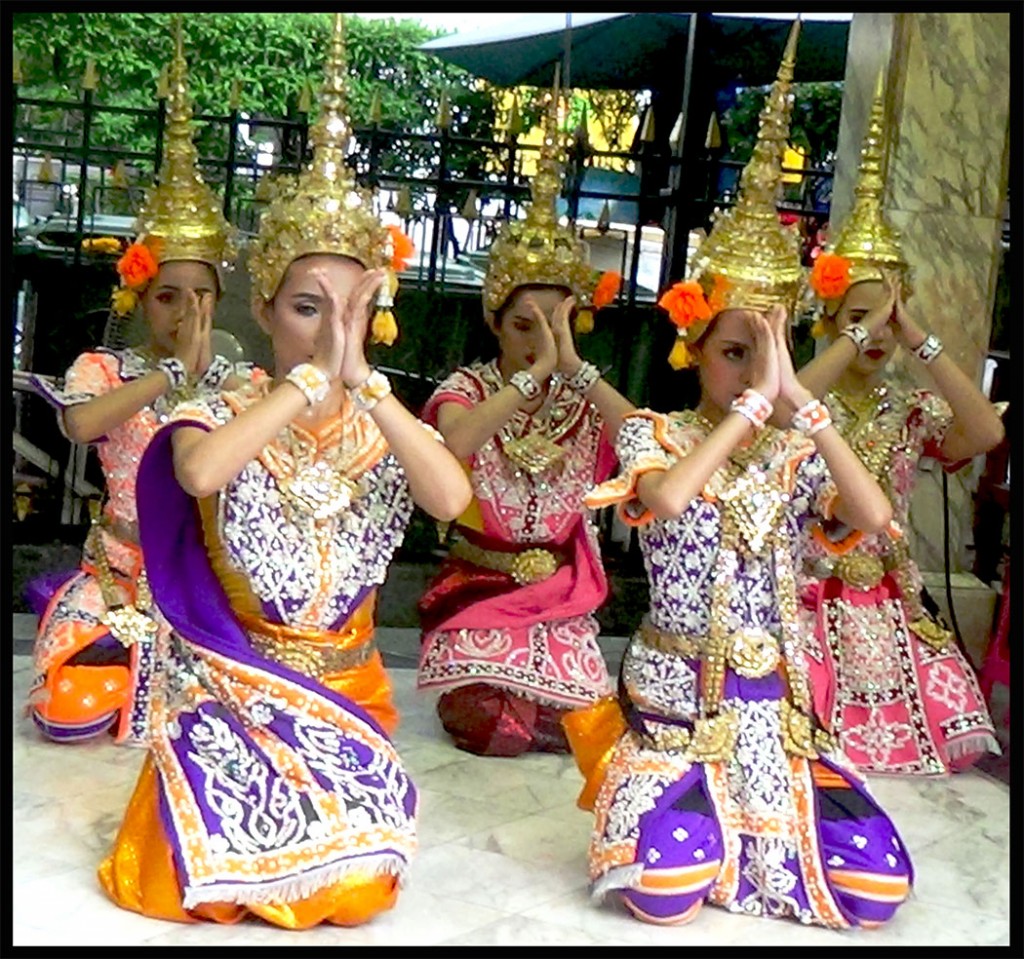 Prior to the rise of Theravada Buddhism, both Indian Brahmanic religion and Mahayana Buddhism were present in Thailand. Influences from both these traditions can still be seen in present-day Thai folklore. Brahmanist shrines play an important role in Thai folk religion, and the Mahayana Buddhist influence is reflected in the presence of figures like Lokesvara, a form of the bodhisattva Avalokitesvara sometimes incorporated into Thailand’s iconography.[3]
Prior to the rise of Theravada Buddhism, both Indian Brahmanic religion and Mahayana Buddhism were present in Thailand. Influences from both these traditions can still be seen in present-day Thai folklore. Brahmanist shrines play an important role in Thai folk religion, and the Mahayana Buddhist influence is reflected in the presence of figures like Lokesvara, a form of the bodhisattva Avalokitesvara sometimes incorporated into Thailand’s iconography.[3]
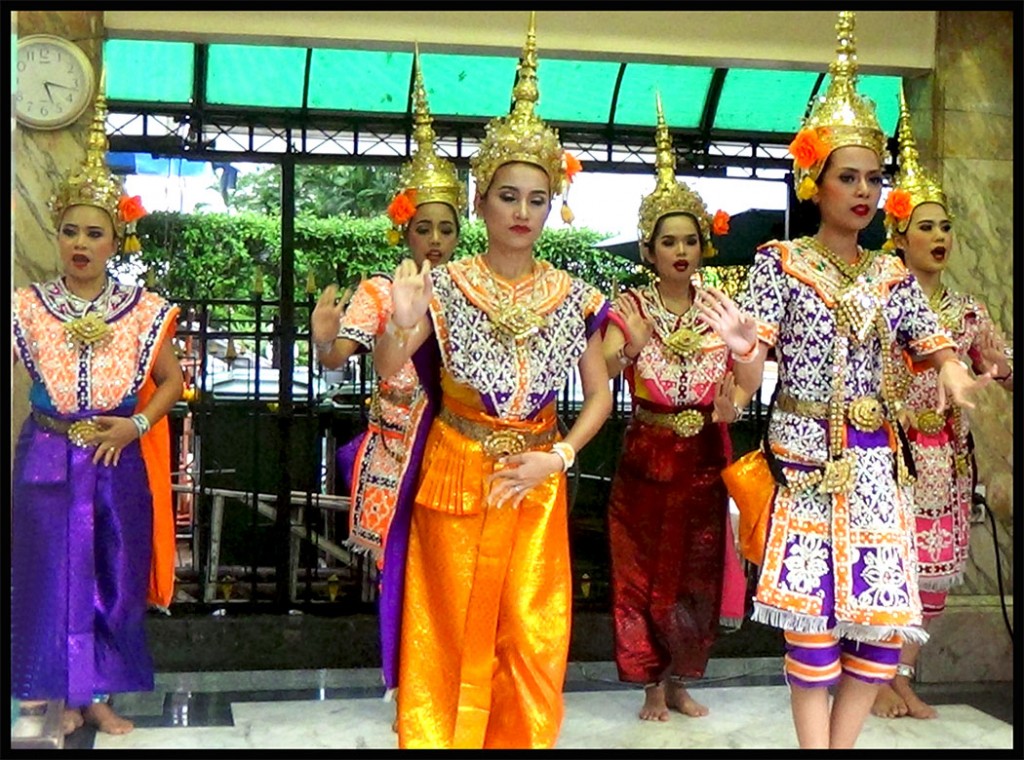 The traditional customs and the folklore of Thai people were gathered and described by Phya Anuman Rajadhon in the 20th century, at a time when modernity changed the face of Thailand and a great number of traditions disappeared or became adapted to modern life. Still, the striving towards refinement, rooted in ancient Siamese culture, consisting of promoting that which is refined and avoiding coarseness is a major focus of the daily life of Thai people and high on their scale of values.[5]
The traditional customs and the folklore of Thai people were gathered and described by Phya Anuman Rajadhon in the 20th century, at a time when modernity changed the face of Thailand and a great number of traditions disappeared or became adapted to modern life. Still, the striving towards refinement, rooted in ancient Siamese culture, consisting of promoting that which is refined and avoiding coarseness is a major focus of the daily life of Thai people and high on their scale of values.[5]
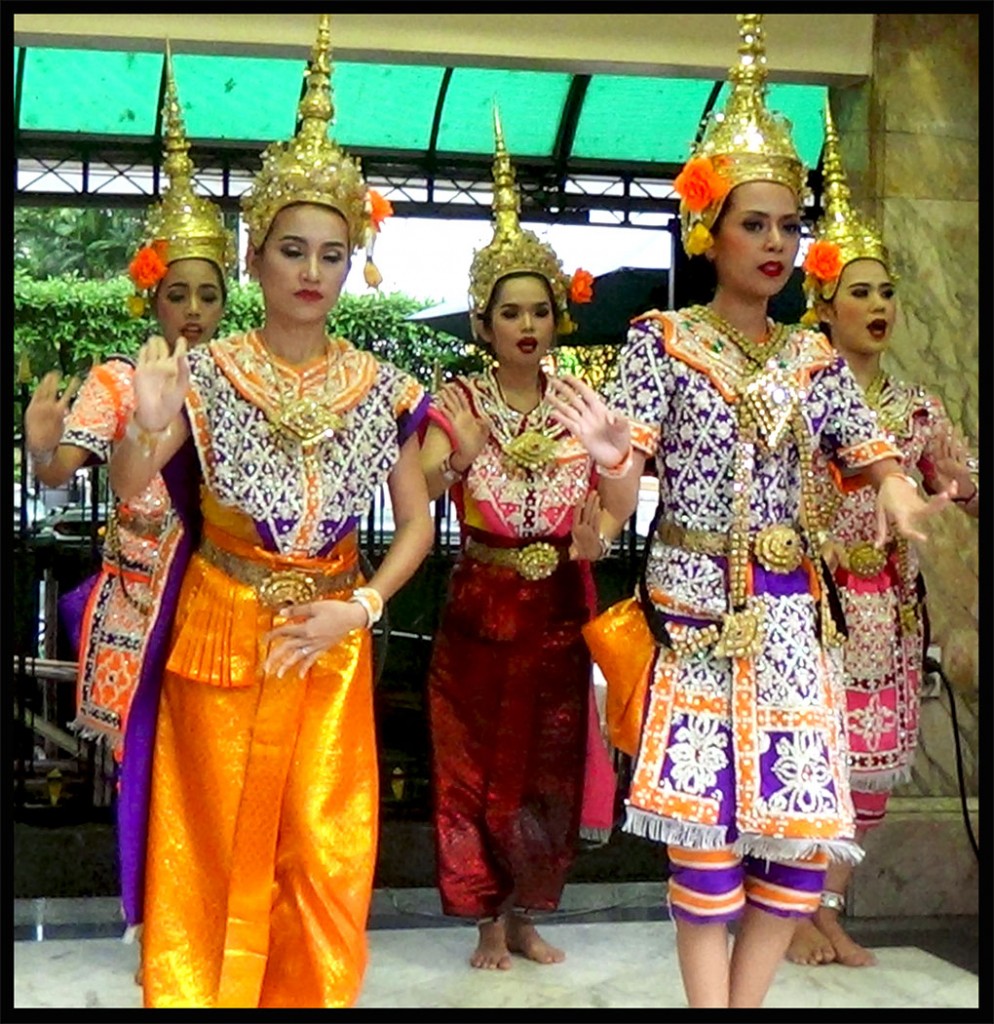 One of the most distinctive Thai customs is the wai. Used in greetings, leave-taking, or as an acknowledgement, it comes in many forms, reflecting the relative status of those involved. Generally the salutation involves a prayer-like gesture with the hands, derived from the Añjali Mudr? of the Indian subcontinent, and it also may include a slight bow of the head. This salutation is often accompanied by a serene smile symbolizing a welcoming disposition and a pleasant attitude. Thailand is often referred to as the “land of smiles” in tourist brochures.
One of the most distinctive Thai customs is the wai. Used in greetings, leave-taking, or as an acknowledgement, it comes in many forms, reflecting the relative status of those involved. Generally the salutation involves a prayer-like gesture with the hands, derived from the Añjali Mudr? of the Indian subcontinent, and it also may include a slight bow of the head. This salutation is often accompanied by a serene smile symbolizing a welcoming disposition and a pleasant attitude. Thailand is often referred to as the “land of smiles” in tourist brochures.
 Public displays of affection are not overly common in traditional Thai society, especially between lovers.[6] It is becoming more common, especially among the younger generation.
Public displays of affection are not overly common in traditional Thai society, especially between lovers.[6] It is becoming more common, especially among the younger generation.
A notable social norm holds that touching someone on the head may be considered rude. It is also considered rude to place one’s feet at a level above someone else’s head, especially if that person is of higher social standing. This is because the Thai people consider the foot to be the dirtiest and lowliest part of the body, and the head the most respected and highest part of the body. This also influences how Thais sit when on the ground—their feet always pointing away from others, tucked to the side or behind them. Pointing at or touching something with the feet is also considered rude.
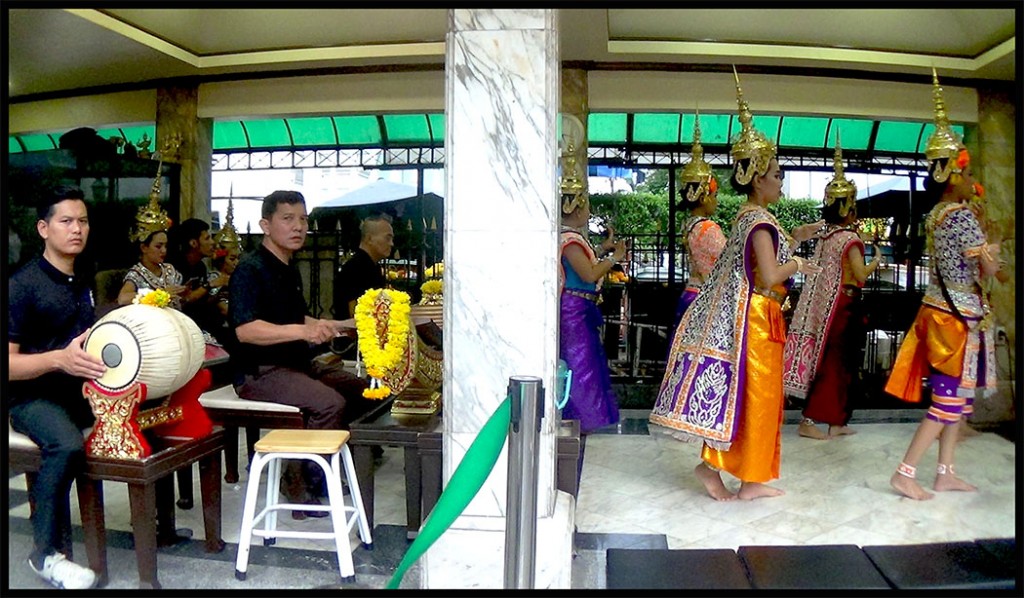 Since a serene disposition is valued, conflict and sudden displays of anger are eschewed in Thai culture. For these reasons, visitors should take care not to create conflict or to display anger. Disagreements or disputes should be handled with a smile and no attempt should be made to assign blame to another. In everyday life in Thailand, there is a strong emphasis on the concept of sanuk; the idea that life should be fun. Because of this, Thais can be quite playful at work and during day-to-day activities. Displaying positive emotions in social interactions is also important in Thai culture.
Since a serene disposition is valued, conflict and sudden displays of anger are eschewed in Thai culture. For these reasons, visitors should take care not to create conflict or to display anger. Disagreements or disputes should be handled with a smile and no attempt should be made to assign blame to another. In everyday life in Thailand, there is a strong emphasis on the concept of sanuk; the idea that life should be fun. Because of this, Thais can be quite playful at work and during day-to-day activities. Displaying positive emotions in social interactions is also important in Thai culture.
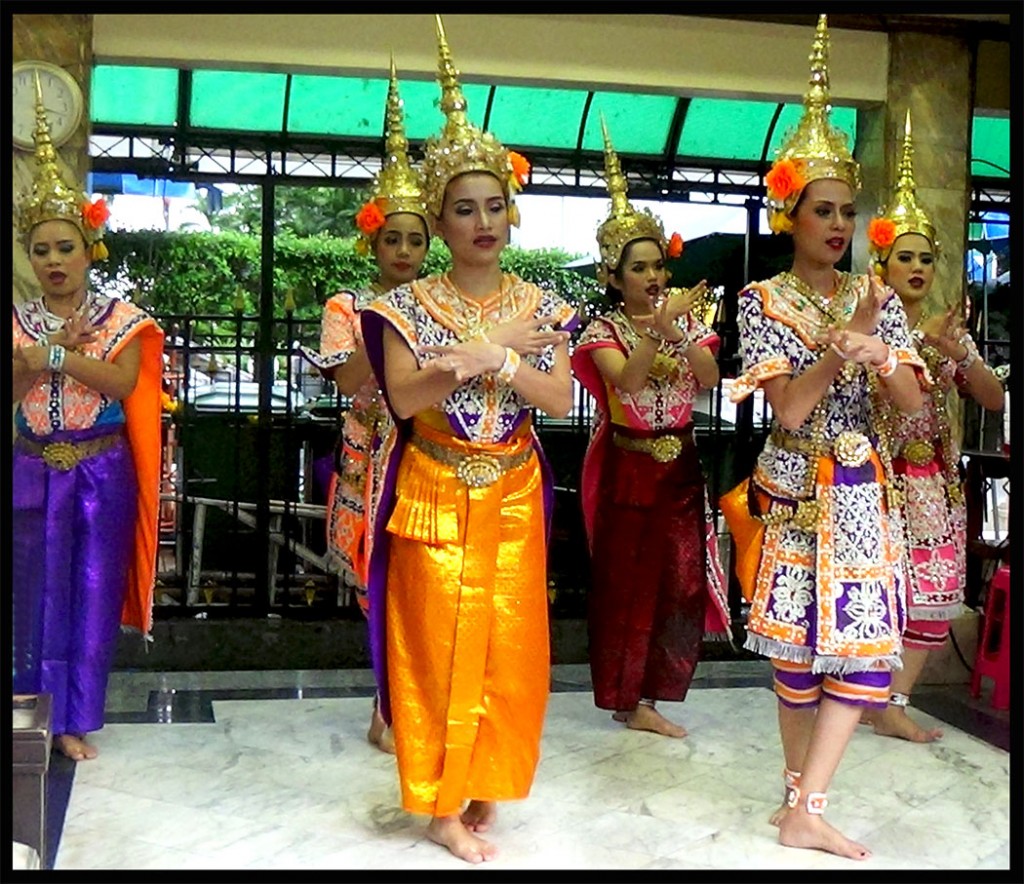 Often, Thais will deal with disagreements, minor mistakes, or misfortunes by using the phrase mai pen rai, translated as “it doesn’t matter”. The ubiquitous use of this phrase in Thailand reflects a disposition towards minimizing conflict, disagreements or complaints. A smile and the sentence “mai pen rai” indicates that the incident is not important and therefore there is no conflict or shame involved.
Often, Thais will deal with disagreements, minor mistakes, or misfortunes by using the phrase mai pen rai, translated as “it doesn’t matter”. The ubiquitous use of this phrase in Thailand reflects a disposition towards minimizing conflict, disagreements or complaints. A smile and the sentence “mai pen rai” indicates that the incident is not important and therefore there is no conflict or shame involved.
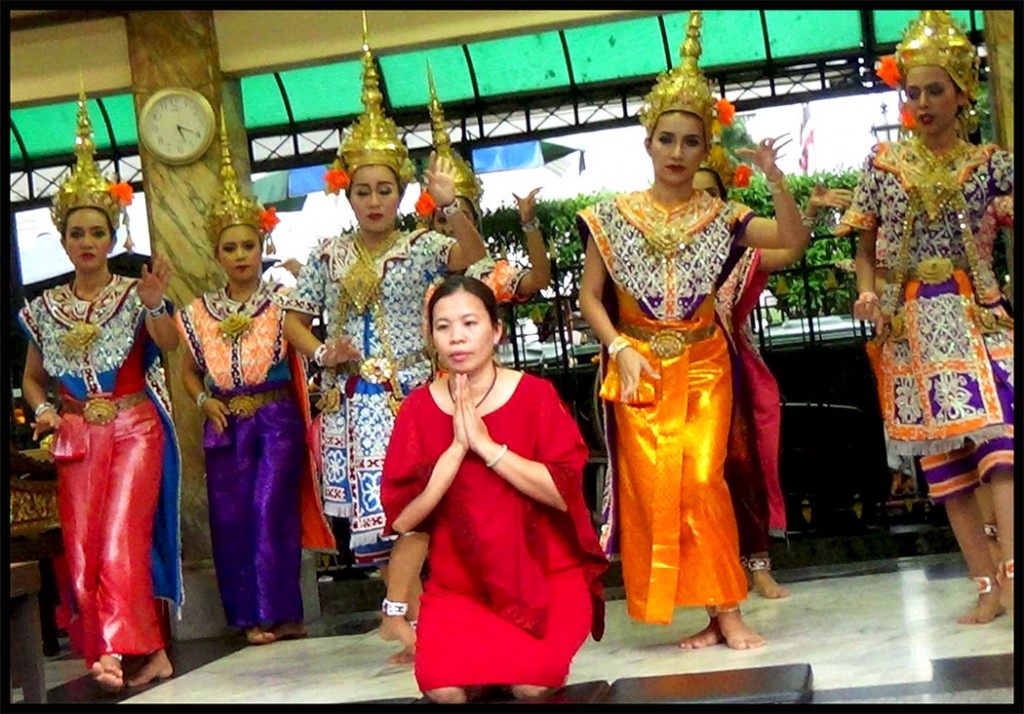 Respect for hierarchy is a very important value for Thai people. The custom of bun khun emphasizes the indebtedness towards parents, as well as towards guardians, teachers, and caretakers. It describes the feelings and practices involved in certain relationships organized around generalized reciprocity, the slow-acting accounting of an exchange calculated according to locally interpreted scales and measures.[7] It is also considered rude to step on any type of Thai currency (Thai coin or banknote) as they include a likeness of the King of Thailand.
Respect for hierarchy is a very important value for Thai people. The custom of bun khun emphasizes the indebtedness towards parents, as well as towards guardians, teachers, and caretakers. It describes the feelings and practices involved in certain relationships organized around generalized reciprocity, the slow-acting accounting of an exchange calculated according to locally interpreted scales and measures.[7] It is also considered rude to step on any type of Thai currency (Thai coin or banknote) as they include a likeness of the King of Thailand.
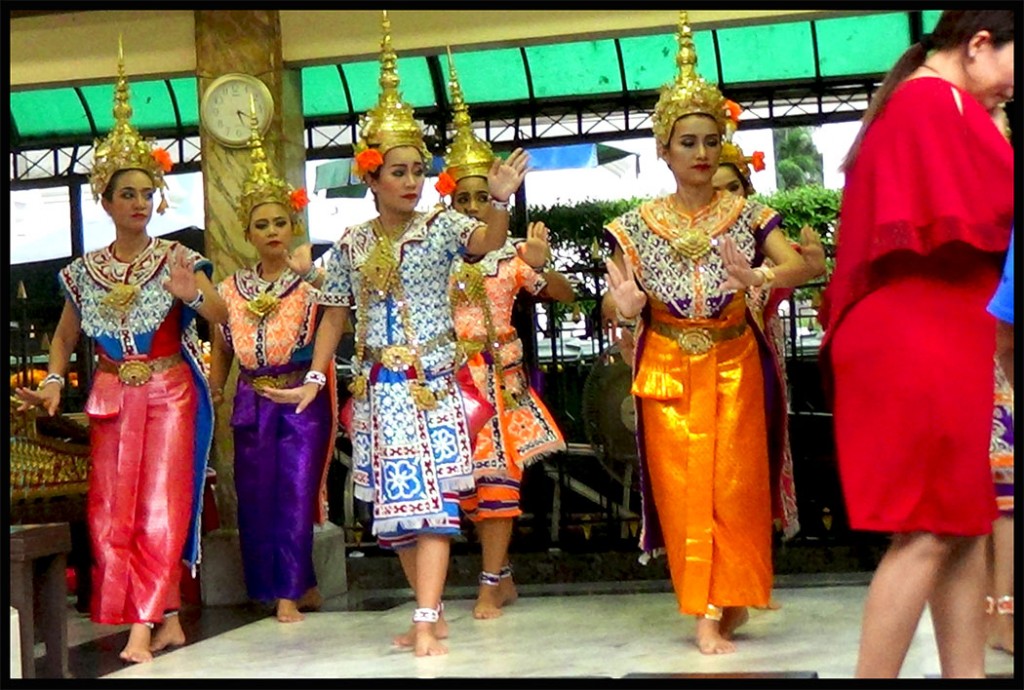 There are a number of Thai customs relating to the special status of monks in Thai society. Thai monks are forbidden physical contact with women. Women are therefore expected to make way for passing monks to ensure that accidental contact does not occur. A variety of methods are employed to ensure that no incidental contact (or the appearance of such contact) between women and monks occurs. Women making offerings to monks place their donation at the feet of the monk, or on a cloth laid on the ground or a table. Powders or unguents intended to carry a blessing are applied to Thai women by monks using the end of a candle or stick. Laypersons are expected to sit or stand with their heads at a lower level than that of a monk. Within a temple, monks may sit on a raised platform during ceremonies to make this easier to achieve.
There are a number of Thai customs relating to the special status of monks in Thai society. Thai monks are forbidden physical contact with women. Women are therefore expected to make way for passing monks to ensure that accidental contact does not occur. A variety of methods are employed to ensure that no incidental contact (or the appearance of such contact) between women and monks occurs. Women making offerings to monks place their donation at the feet of the monk, or on a cloth laid on the ground or a table. Powders or unguents intended to carry a blessing are applied to Thai women by monks using the end of a candle or stick. Laypersons are expected to sit or stand with their heads at a lower level than that of a monk. Within a temple, monks may sit on a raised platform during ceremonies to make this easier to achieve.
 When sitting in a temple, one is expected to point one’s feet away from images of the Buddha. Shrines inside Thai residences are arranged so as to ensure that the feet are not pointed towards the religious icons, such as placing the shrine on the same wall as the head of a bed, if a house is too small to remove the shrine from the bedroom entirely.
When sitting in a temple, one is expected to point one’s feet away from images of the Buddha. Shrines inside Thai residences are arranged so as to ensure that the feet are not pointed towards the religious icons, such as placing the shrine on the same wall as the head of a bed, if a house is too small to remove the shrine from the bedroom entirely.
It is also customary to remove one’s footwear before entering a home or the sacred areas within a temple, and not to step on the threshold.
 Traditional Thai clothing is called chut thai (Thai: ?????? Thai pronunciation: [t??út.t?aj]) which literally means “Thai outfit”. It can be worn by men, women, and children. Chut thai for women usually consists of a pha nung or a chong kraben, a blouse, and a sabai. Northern and northeastern women may wear a sinh instead of a pha nung and a chong kraben with either a blouse or a suea pat. Chut thai for men includes a chong kraben or pants, a Raj pattern shirt, with optional knee-length white socks and a sabai. Chut thai for northern Thai men is composed of a sado, a white Manchu styled jacket, and sometimes a khian hua. In formal occasions, people may choose to wear a so-called formal Thai national costume.
Traditional Thai clothing is called chut thai (Thai: ?????? Thai pronunciation: [t??út.t?aj]) which literally means “Thai outfit”. It can be worn by men, women, and children. Chut thai for women usually consists of a pha nung or a chong kraben, a blouse, and a sabai. Northern and northeastern women may wear a sinh instead of a pha nung and a chong kraben with either a blouse or a suea pat. Chut thai for men includes a chong kraben or pants, a Raj pattern shirt, with optional knee-length white socks and a sabai. Chut thai for northern Thai men is composed of a sado, a white Manchu styled jacket, and sometimes a khian hua. In formal occasions, people may choose to wear a so-called formal Thai national costume.
Thai dining etiquette refers to the traditional and proper behaviors of Thai people while eating. Since Thai society has a lot of big families, so having a meal together and sharing the food between members of the family is Thai traditional dining style. Generally, Thais eat rice as the main food and share the rice side dishes with one another.
Traditionally, in Thailand, people have a meal on the floor mat and eat the food with their right hands. The rice dishes are on the outer circle while the shared dishes are in the center of the circle with shared spoons to transfer the side dish food to their own rice dish.
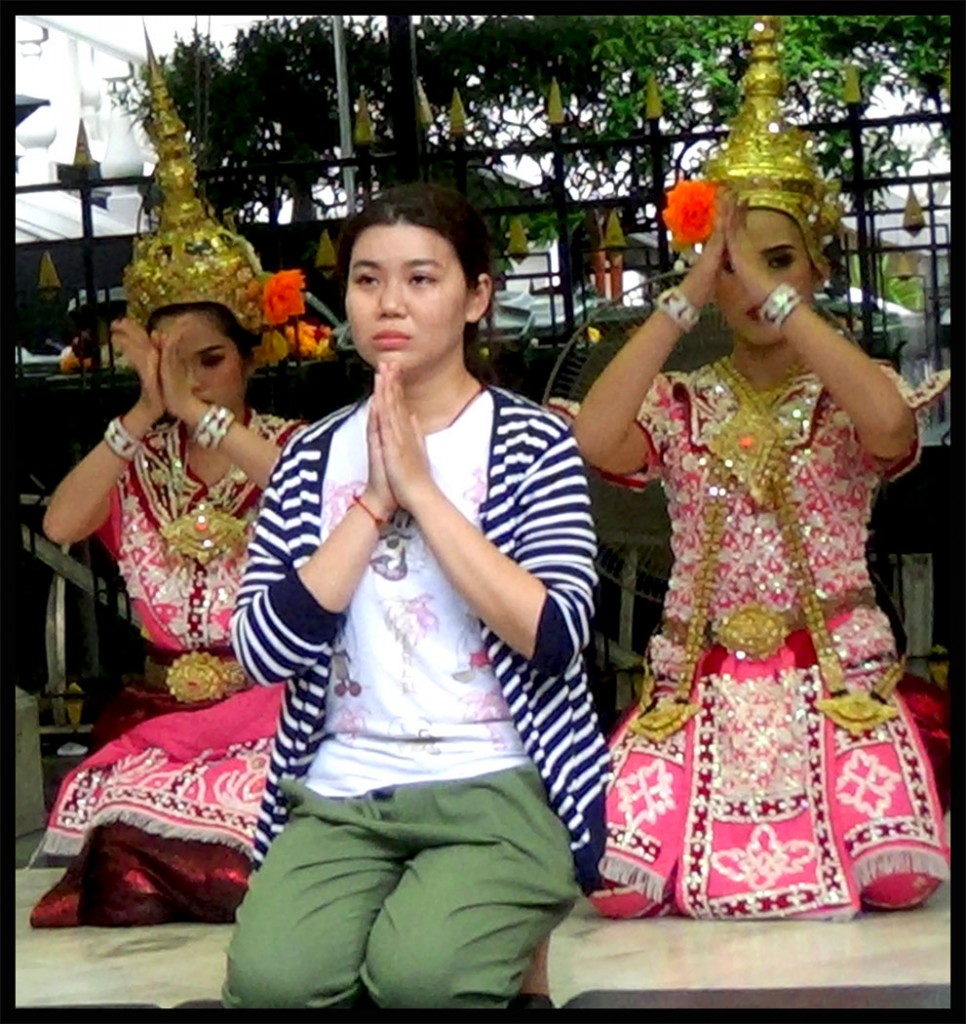 In the reign of King Mongkut (Rama IV), King Chulalongkorn the Great (Rama V), Prince Chulalongkorn at that time, was educated by an English woman, courted Western diplomats and leaders and travelled abroad, observe and learn the western dining and he found out the fork and knife are not suitable for Thai food (no need to chop anything, he introduced the fork and spoon and so began the use of cutlery in Thailand. Thais use the fork to push the food onto the spoon (right hand), which then goes into your mouth instead of making the meat stable for the knife function.[8] Nowadays, Thai dining is mixed with various countries’ dining cultures, so Thai people use a lot of styles to eat not only with spoon and fork one but also chopstick, knife and bare hand as well.
In the reign of King Mongkut (Rama IV), King Chulalongkorn the Great (Rama V), Prince Chulalongkorn at that time, was educated by an English woman, courted Western diplomats and leaders and travelled abroad, observe and learn the western dining and he found out the fork and knife are not suitable for Thai food (no need to chop anything, he introduced the fork and spoon and so began the use of cutlery in Thailand. Thais use the fork to push the food onto the spoon (right hand), which then goes into your mouth instead of making the meat stable for the knife function.[8] Nowadays, Thai dining is mixed with various countries’ dining cultures, so Thai people use a lot of styles to eat not only with spoon and fork one but also chopstick, knife and bare hand as well.
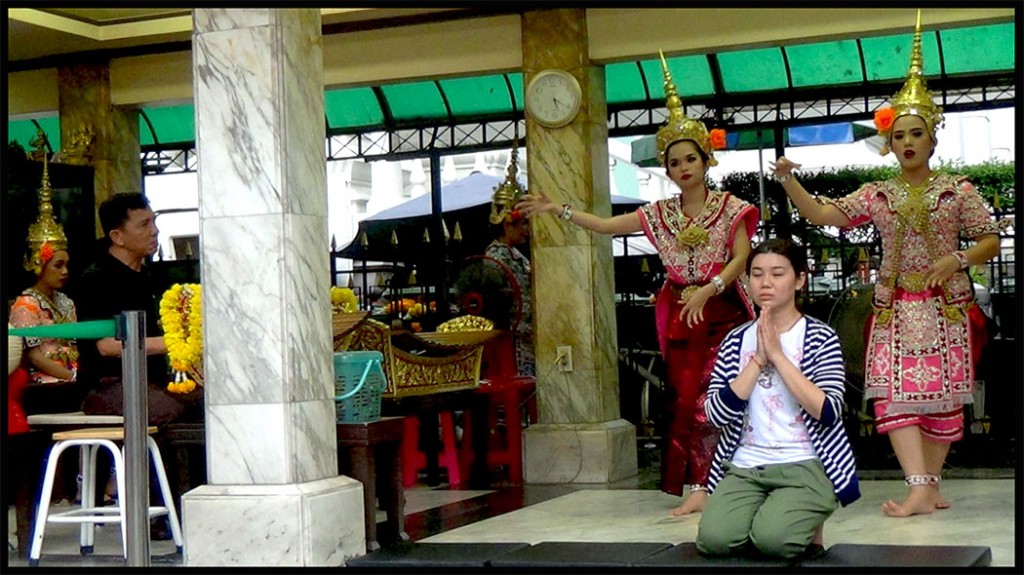 Regional Thai dining[9]
Regional Thai dining[9]
- Central part of Thailand
In central Thailand, sitting on a chair, eating at a table and using a fork, spoon and shared spoon are longstanding customs (Rama IV). For Thai rich family dining, variously shaped napkins are added on the table and also employ waiters or waitresses to serve the food and beverages beside the table. For some poor people the shared spoon is not used.
Thai northern people still preserve their traditional culture by using small food bowls and putting them on a “Kan tok” (Thai northern small table). They are decorated with wood, pearl or yellowish gold. Sticky rice, glutinous rice is the main food eaten with shared dishes. It is contained in “Kratip Song Soong”, high-height container for sticky rice. Beside “Kan tok”, there is “Kon Tho Din”, jar made from the soil and “Kan ngeaun” silver cup. After finishing the main course, the desserts are served and also “Buri Chai Yo”, the cigarette, which is end of the meal.
- Northeastern part of Thailand, “Isan”
Typically the food is served on a large flower-patterned circular zinc tray. The sticky rice contained in ”Kra Tip Song Taei” (low-height container for sticky rice). Then the desserts are served.
The local people eat on a floor mat. The dishes are placed on the center of it. They sit in the circle and traditionally eat with their bare hands. The drinking water is contained in “Kan”or”Jok”, (little Thai cup.) Nowadays, fork and spoon are used instead of bare hands. Sitting on a chair and eating at a table now predominates. There are only few local people who still preserve the original dinning style.
Ways of serving food in Thailand
There are two main ways to serve Thai food, “Raad Kao”, individual dish and “Gap Kao”, separate dish.[10]
In the past, Thai people had large families. Due to the difficulty of eating together at the same time, placing the rice side dish and the rice on the same dish and serving individually is to some extent supplanting the traditional Thai dinning style.
The rice side dishes are separately served with the rice (not same dish). Normally, this style is suitable for eating with others. The shared rice side dishes are in the center of the circle. Each has their own rice while the side dishes are shared by transferring them with the shared spoons to the individual rice dishes.
- Individual dish
The spoon is on the right and the fork is on the left side of the dish.
- Shared dishes
For rice dishes, the spoon is on the right and the fork is on the left side of the dish. Shared dishes are placed in the center of the table with the serving spoons.
- Ordering
For shared dish style, let the senior of the group order their rice side dish first and then another select the menu which everyone can eat and try to order balance of dish, ordering fish or seafood, pork, shrimp, chicken and vegetarian dishes which encompass a full range of tastes. Spicy, sweet, salty and bitter will all be represented, often all in one dish. When the dishes are served, all of them do not come at once. The food keeps coming and coming.
Thai people eat using the fork and spoon combo method. The spoon acts as the main tool and the fork is the supporting tool pushing the food onto the spoon and the shared spoon is the main tool to scoop the food from shared dish to rice dish. Some people use their own spoon to scoop the food from the shared dish directly but it is not a good dining manner for Thais because they concern about sanitation issue. If the shared dish is curry, it is transferred to an individual little cup first. Then they sip the soup from the spoon. Sipping it from the cup directly is not proper, Moreover, making noise during eating and sipping is impolite in Thailand. On the other hand, talking during eating is not prohibited. However, Thai food menus include a lot of fish and spices of which some parts are not for eating—splitting the food is the general behavior for Thais. Splitting on the spoon, and put them on the edge of the dish or provided dish for the trash is Thai general practice.
After finishing eating, placing the spoon and fork down close together on the bowl/plate, gathering the trash to one side of their dish and stacking the empty plates at the side of the table makes the waiters realize that customer(s) require them to clean the table.
Since there are a lot Chinese families in Thailand, the Chinese culture is mixed with the Thai culture. Sticking up sticks, poking a stick or skewer into food on a plate and having it stick straight upwards, is impolite. To be polite using a toothpick, block the mouth with one hand before you pick with the other.
The bill is usually picked up and paid by the wealthiest or most important person[11] or inviter or oldest person.[12] If customers are friends the bills are usually paid separately.
Birth traditions and beliefs
Main article: Birth in Thailand
Traditional principles concerning pregnancy and childbirth are largely influenced by folk beliefs, especially in rural areas of central and north Thailand. Modern practices follow the Western medical model.
See also: Thai names,
Thai people universally have one, or occasionally more, short nicknames (Thai: ???????? name-play) that they use with friends and family. Often first given shortly after birth by friends or an older family member, these nicknames are overwhelmingly one syllable[13] (or worn down from two syllables to one). Though they may be simply shortened versions of a full name, they quite frequently have no relation to the person’s full name and are often humorous and/or nonsense words. Babies may be given a nickname of a relative or named for a characteristic of birth, e.g., “little”. Traditionally, nicknames would relate to things of low value, e.g., “dirt”, which was to convince evil spirits lurking in the vicinity that the child was not worthy their attention. Today this folk custom is on the decline.
 Some common nicknames translate into English as “small”, “fatty”, “pig”, “little”, “frog”, “banana”, “green”, or “girl/boy”. Though rare, sometimes Thai children are given nicknames in the order they were born into the family (i.e., “one”, “two”, “three”, etc.). Nicknames are useful because official Thai names are often long, particularly among Thais of Chinese descent, whose lengthy surnames stem from an attempt to translate Chinese names into Thai equivalents, or among Thai with similarly lengthy Sanskrit-derived names. In recent years, English language words have become popular nicknames. Examples include: “Ice” (????); “Bank” (?????); “New” (???); “Ball” (???), and even “Beer” (??????).[13]
Some common nicknames translate into English as “small”, “fatty”, “pig”, “little”, “frog”, “banana”, “green”, or “girl/boy”. Though rare, sometimes Thai children are given nicknames in the order they were born into the family (i.e., “one”, “two”, “three”, etc.). Nicknames are useful because official Thai names are often long, particularly among Thais of Chinese descent, whose lengthy surnames stem from an attempt to translate Chinese names into Thai equivalents, or among Thai with similarly lengthy Sanskrit-derived names. In recent years, English language words have become popular nicknames. Examples include: “Ice” (????); “Bank” (?????); “New” (???); “Ball” (???), and even “Beer” (??????).[13]
Thai Buddhist marriage ceremonies are generally divided into two parts: a Buddhist component, which includes the recitation of prayers and the offering of food and other gifts to monks and images of the Buddha, and a non-Buddhist component rooted in folk traditions, which centers on the couple’s families.
In former times, it was unknown for Buddhist monks to be present at any stage of the marriage ceremony itself. As monks were required to attend to the dead during funerals, their presence at a marriage (which was associated with fertility, and intended to produce children) was considered a bad omen. A couple would seek a blessing from their local temple before or after being married, and might consult a monk for astrological advice in setting an auspicious date for the wedding. The non-Buddhist portions of the wedding would take place away from the temple, and would often take place on a separate day.
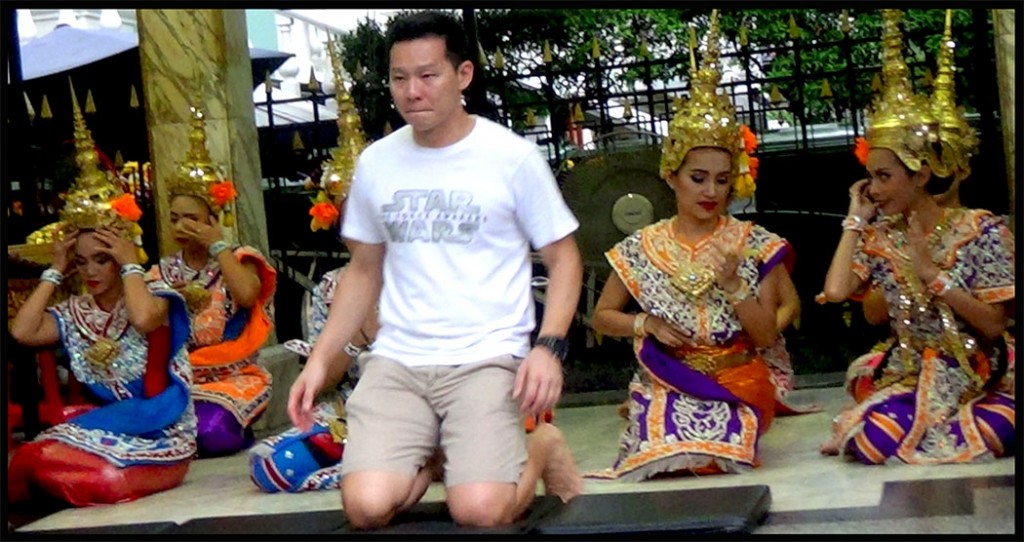 In modern times, these prohibitions have been significantly relaxed. It is not uncommon for a visit to a temple to be made on the same day as the non-Buddhist portions of a wedding, or even for the wedding to take place within the temple. While a division is still commonly observed between the “religious” and “secular” portions of a wedding service, it may be as simple as the monks present for the Buddhist ceremony departing to take lunch once their role is complete.
In modern times, these prohibitions have been significantly relaxed. It is not uncommon for a visit to a temple to be made on the same day as the non-Buddhist portions of a wedding, or even for the wedding to take place within the temple. While a division is still commonly observed between the “religious” and “secular” portions of a wedding service, it may be as simple as the monks present for the Buddhist ceremony departing to take lunch once their role is complete.
 During the Buddhist component of the wedding service, the couple first bow before the image of the Buddha. They then recite certain basic Buddhist prayers or chants (typically including taking the Three Refuges and the Five Precepts), and light incense and candles before the image. The parents of the couple may then be called upon to “connect” them, by placing upon the heads of the bride and groom twin loops of string or thread that link the couple together. The couple may then make offerings of food, flowers, and medicine to the monks present. Cash gifts (usually placed in an envelope) may also be presented to the temple at this time.
During the Buddhist component of the wedding service, the couple first bow before the image of the Buddha. They then recite certain basic Buddhist prayers or chants (typically including taking the Three Refuges and the Five Precepts), and light incense and candles before the image. The parents of the couple may then be called upon to “connect” them, by placing upon the heads of the bride and groom twin loops of string or thread that link the couple together. The couple may then make offerings of food, flowers, and medicine to the monks present. Cash gifts (usually placed in an envelope) may also be presented to the temple at this time.
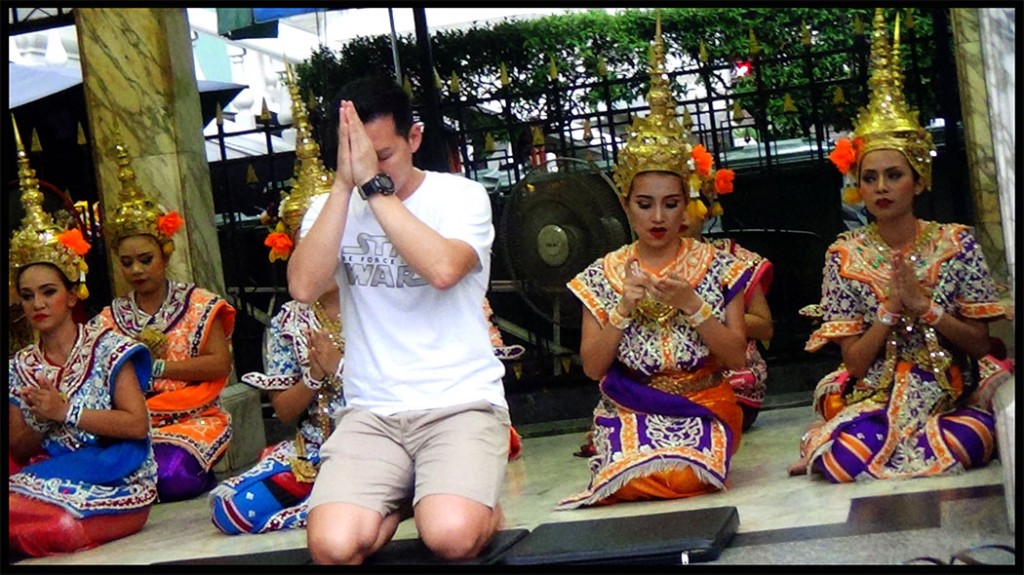 The monks may then unwind a small length of thread that is held between the hands of the assembled monks. They begin a series of recitations of Pali scriptures intended to bring merit and blessings to the new couple. The string terminates with the lead monk, who may connect it to a container of water that will be “sanctified” for the ceremony. Merit is said to travel through the string and be conveyed to the water. A similar arrangement is used to transfer merit to the dead at a funeral, further evidence of the weakening of the taboo on mixing funerary imagery and trappings with marriage ceremonies. Blessed water may be mixed with wax drippings from a candle lit before the Buddha image and other unguents and herbs to create a paste that is then applied to the foreheads of the bride and groom to create a small dot, similar to the marking made with red ochre on Hindu devotees. The bride’s mark is created with the butt end of the candle rather than the monk’s thumb, in keeping with the Vinaya prohibition against touching women.
The monks may then unwind a small length of thread that is held between the hands of the assembled monks. They begin a series of recitations of Pali scriptures intended to bring merit and blessings to the new couple. The string terminates with the lead monk, who may connect it to a container of water that will be “sanctified” for the ceremony. Merit is said to travel through the string and be conveyed to the water. A similar arrangement is used to transfer merit to the dead at a funeral, further evidence of the weakening of the taboo on mixing funerary imagery and trappings with marriage ceremonies. Blessed water may be mixed with wax drippings from a candle lit before the Buddha image and other unguents and herbs to create a paste that is then applied to the foreheads of the bride and groom to create a small dot, similar to the marking made with red ochre on Hindu devotees. The bride’s mark is created with the butt end of the candle rather than the monk’s thumb, in keeping with the Vinaya prohibition against touching women.
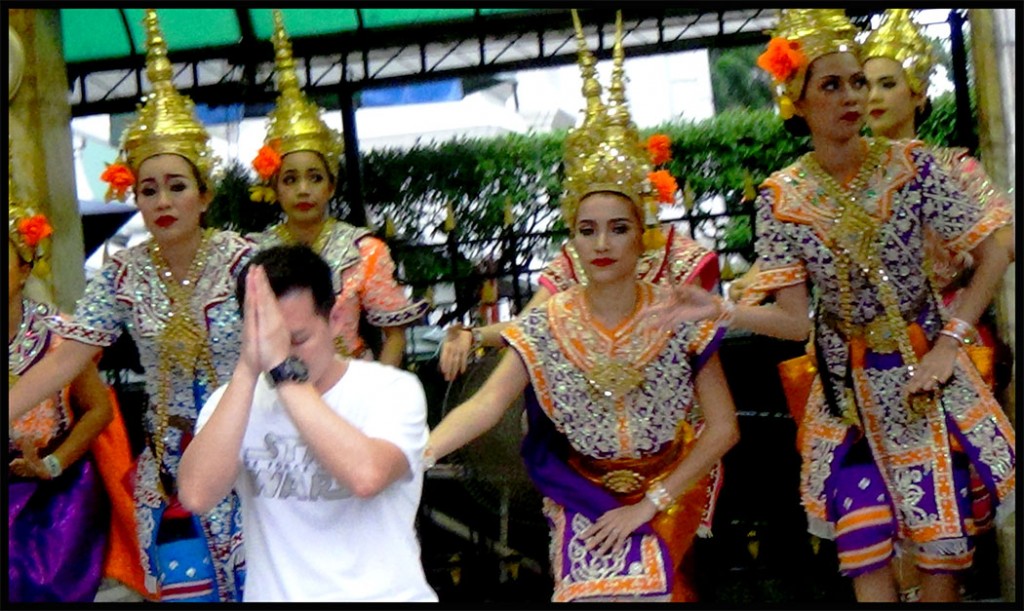 The highest-ranking monk present may elect to say a few words to the couple, offering advice or encouragement. The couple may then make offerings of food to the monks, at which point the Buddhist portion of the ceremony is concluded.
The highest-ranking monk present may elect to say a few words to the couple, offering advice or encouragement. The couple may then make offerings of food to the monks, at which point the Buddhist portion of the ceremony is concluded.
The Thai dowry system is known as the sin sodt (Thai: ??????). Traditionally, the groom will be expected to pay a sum of money to the family, to compensate them and to demonstrate that the groom is financially capable of taking care of their daughter. Sometimes, this sum is purely symbolic, and will be returned to the bride and groom after the wedding has taken place.
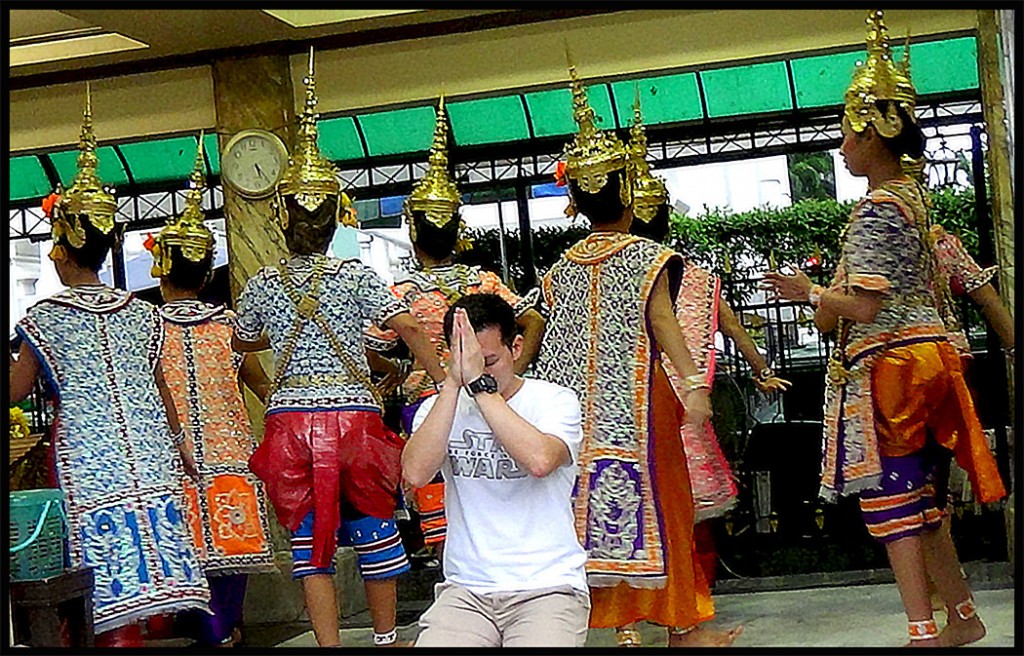 The religious component of marriage ceremonies between Thai Muslims are markedly different from that described above. The Imam of the local mosque, the groom, the father of the bride, men in the immediate family, and important men in the community sit in a circle during the ceremony, conducted by the Imam. All the women, including the bride, sit in a separate room and do not have any direct participation in the ceremony. The secular component of the ceremony, however, is often nearly identical to the secular part of Thai Buddhist wedding ceremonies. The only notable difference here is the type of meat served to guests (goat and/or beef instead of pork). Thai Muslims frequently, though not always, also follow the conventions of the Thai dowry system.
The religious component of marriage ceremonies between Thai Muslims are markedly different from that described above. The Imam of the local mosque, the groom, the father of the bride, men in the immediate family, and important men in the community sit in a circle during the ceremony, conducted by the Imam. All the women, including the bride, sit in a separate room and do not have any direct participation in the ceremony. The secular component of the ceremony, however, is often nearly identical to the secular part of Thai Buddhist wedding ceremonies. The only notable difference here is the type of meat served to guests (goat and/or beef instead of pork). Thai Muslims frequently, though not always, also follow the conventions of the Thai dowry system.
Traditionally, funerals last for at least one week. Crying is discouraged during the funeral, so as not to worry the spirit of the deceased. Many activities surrounding the funeral are intended to make merit for the deceased. Copies of Buddhist scriptures may be printed and distributed in the name of the deceased, and gifts are usually given to a local temple. Monks are invited to chant prayers that are intended to provide merit for the deceased, as well as to provide protection against the possibility of the dead relative returning as a malicious spirit. A picture of the deceased from his/her best days will often be displayed next to the coffin. Often, a thread is connected to the corpse or coffin which is held by the chanting monks during their recitation; this thread is intended to transfer the merit of the monks’ recitation to the deceased. The corpse is cremated, and the urn with the ash is usually kept in a chedi in the local temple.
Thai Chinese and Thai Muslim minorities bury their deceased according to the rituals of their respective communities.
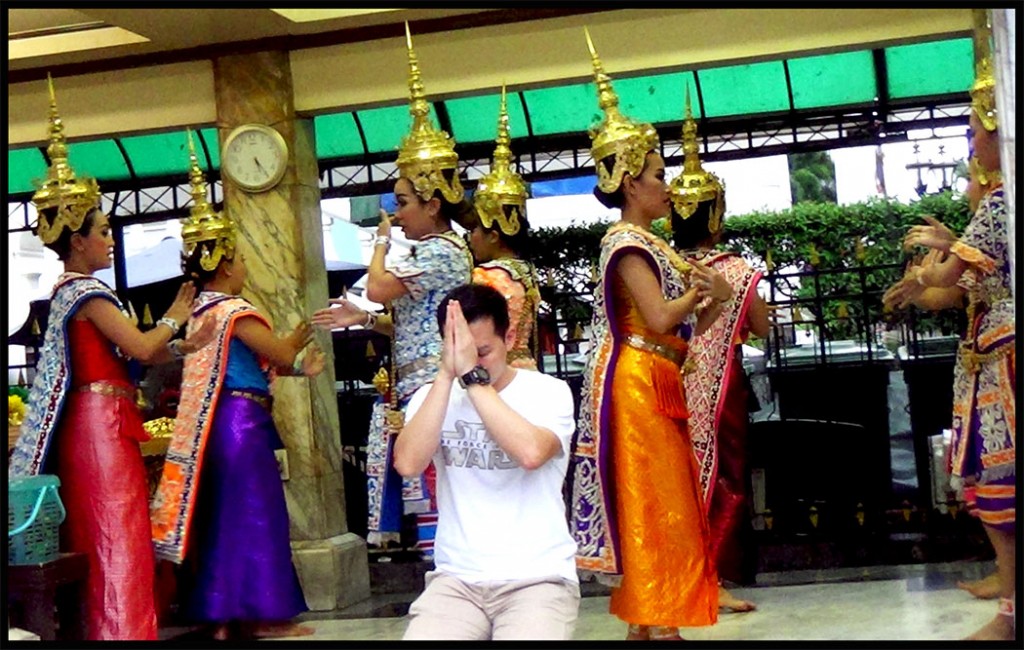 National anthem and respect for the flag and king
National anthem and respect for the flag and king
Twice a day, at 08:00 and again at 18:00, the national anthem is played by all Thai media outlets. Thais stop what they are doing and stand at attention to pay homage to the flag during the anthem. Students in school stand in front of the raised flag and sing the national anthem at 08:00 every school day. The practice dates from 1935 when the regulations for the raising and lowering of the colours was published in the Royal Gazette. The Flag Act of 1979 decreed that those who do not observe the custom by standing in silence during the anthem are subject to a fine of up to 2,000 baht and not more than one year in prison.[14]
In a related practice, the royal anthem of the King of Thailand is played before movies, concerts, and sporting events. All are expected to stand.[citation needed]
Traditional arts
Thai visual arts were traditionally Buddhist. Thai Buddha images from different periods have a number of distinctive styles. Thai temple art and architecture evolved from a number of sources, one of them being Khmer architecture. Contemporary Thai art often combines traditional Thai elements with modern techniques.
Literature in Thailand is heavily influenced by Indian Hindu culture. The most notable works of Thai literature are a version of the Ramayana, a Hindu religious epic, called the Ramakien, written in part by Kings Rama I and Rama II, and the poetry of Sunthorn Phu.
Traditional Thai paintings showed subjects in two dimensions without perspective. The size of each element in the picture reflected its degree of importance. The primary technique of composition is that of apportioning areas: the main elements are isolated from each other by space transformers. This eliminated the intermediate ground, which would otherwise imply perspective. Perspective was introduced only as a result of Western influence in the mid-19th century. Monk artist Khrua In Khong is well known as the first artist to introduce linear perspective to Thai traditional art.
There is no tradition of spoken drama in Thailand, the role instead being filled by Thai dance. This is divided into three categories: Khon, ‘Lakhon, and Likay, Khon being the most elaborate and Likay the most popular. Nang drama, a form of shadow play, is found in the south.
There is also Thai folklore, Sri Thanonchai as an example.
The first detailed European record of khon and other classical Siamese dances was made during the Ayutthaya Kingdom. It described a dramatic tradition and style that are almost identical to the Thai traditions we still see today. Historical evidence clearly establishes that the Thai art of stage plays must have already been perfected by the 17th century. Louis XIV, the Sun King of France, had a formal diplomatic relation with Ayutthaya’s King Narai. In 1687, France sent the diplomat Simon de la Loubère to record all that he saw in the Siamese Kingdom and its traditions. In his account Du Royaume de Siam, La Loubère carefully observed the classic 17th century theatre of Siam, including an epic battle scene from a khon performance, and recorded what he saw in great detail:
“The Siamese have three sorts of Stage Plays: That which they call Cone [khon] is a figure dance, to the sound of the violin and some other instruments. The dancers are masked and armed, and represent rather a combat than a dance. And though every one runs into high motions, and extravagant postures, they cease not continually to intermix some word. Most of their masks are hideous, and represent either monstrous Beasts, or kinds of Devils. The Show which they call Lacone is a poem intermix with Epic and Dramatic, which lasts three days, from eight in the morning till seven at night. They are histories in verse, serious, and sung by several actors always present, and which do only sing reciprocally…. The Rabam is a double dance of men and women, which is not martial, but gallant … they can perform it without much tying themselves, because their way of dancing is a simple march round, very slow, and without any high motion; but with a great many slow contortions of the body and arms.”[15]:49
Of the attires of Siamese khon dancers, La Loubère recorded that: “[T]hose that dance in Rabam, and Cone, have gilded paper-bonnets, high and pointed, like the Mandarins caps of ceremony, but which hang down at the sides below their ears, which are adorned with counterfeit stones, and with two pendants of gilded wood.[15]:49
Today “ram Thai” (Thai: ?????), ‘Thai dance’. Thai dance, like many forms of traditional Asian dance, can be divided into two major categories that correspond roughly to the high art (classical dance) and low art (folk dance) distinction.
Although traditional Thai performing arts are not as vibrant as they once were, suffering inroads from Western entertainment and generally changing tastes, Thai dance drama is not extinct. What survives displays the elegance of an art form refined over centuries and supported by regal patronage.[citation needed]
Aside from folk and regional dances (southern Thailand’s Indian-influenced Menora dance, for example), the two major forms of Thai classical dance drama are khon and Lakhon nai. In the beginning both were exclusively court entertainments and it was not until much later that a popular style of dance theater, Likay, evolved as a diversion for the common folk who had no access to royal performances. Apart from Lakhon nai, Lakhon chatri is also one of the most important Thai dances.
The Music of Thailand includes classical and folk music traditions, e.g., Piphat and Mor lam, respectively, as well as Thai pop music, e.g., “String”. Thai classical music is synonymous with those stylized court ensembles and repertoires that emerged in its present form within the royal centers of Central Thailand some 800 years ago. These ensembles, while being deeply influenced by Khmer and even older practices and repertoires from India, are today uniquely Thai expressions. While the three primary classical ensembles, the Piphat, Khrueang sai and Mahori differ in significant ways, they all share a basic instrumentation and theoretical approach. Each employ the small ching hand cymbals and the krap wooden sticks to mark the primary beat reference.
Several kinds of small drums (klong) are employed in these ensembles to outline the basic rhythmic structure (natab) that is punctuated at the end by the striking of a suspended gong (mong). Seen in its most basic formulation, the classical Thai orchestras are very similar to the Cambodian (Khmer) pinpeat and mahori ensembles, and structurally similar to other orchestras found within the widespread Southeast Asian gong-chime musical culture, such as the large gamelan of Bali and Java, which most likely have their common roots in the diffusion of Vietnamese Dong-Son bronze drums beginning in the first century.
Traditional Thai classical repertoire is anonymous, handed down through an oral tradition of performance in which the names of composers (if, indeed, pieces were historically created by single authors) are not known. However, since the beginning of the modern Bangkok period, composers’ names have been known and, since around the turn of the century, many major composers have recorded their works in notation. Musicians, however, imagine these compositions and notations as generic forms which are realized in full in idiosyncratic variations and improvisations in the context of performance.
For more information please visit the following link:
https://en.wikipedia.org/wiki/Culture_of_Thailand
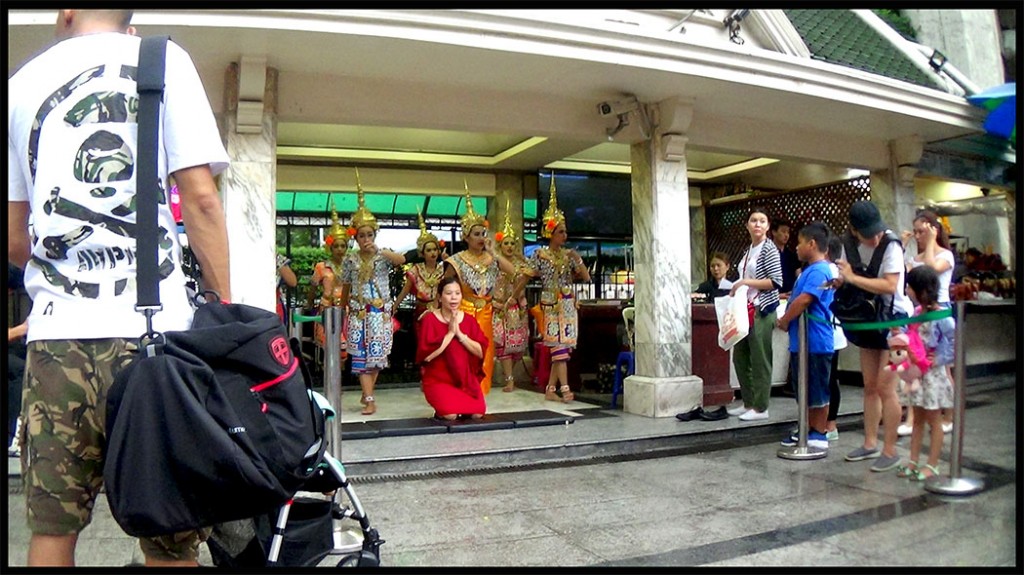
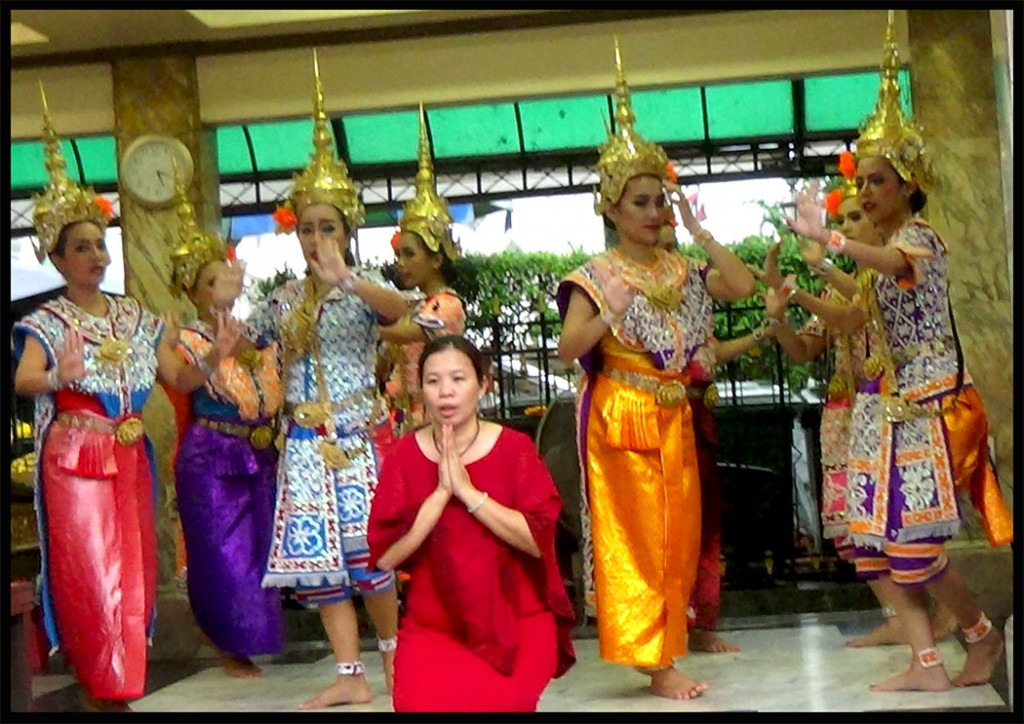 A Worshipper and Thai Classical dancers perform for Pra Phrom (The four-faced Brahma God) at the Erawan Shrine, Bangkok, Thailand
A Worshipper and Thai Classical dancers perform for Pra Phrom (The four-faced Brahma God) at the Erawan Shrine, Bangkok, Thailand
Photograph by Ing-On Vibulbhan-Watts
“People offer prayers and seek blessings at the Erawan Shrine in Bangkok, Thailand. The Erawan Shrine is a Hindu shrine in Bangkok, Thailand, that houses a statue of Phra Phrom, the Thai representation of the Hindu creation god Brahma. A popular tourist attraction, it often features performances by resident Thai dance troupes, who are hired by worshippers in return for seeing their prayers at the shrine answered.”
For more information please visit the following link:
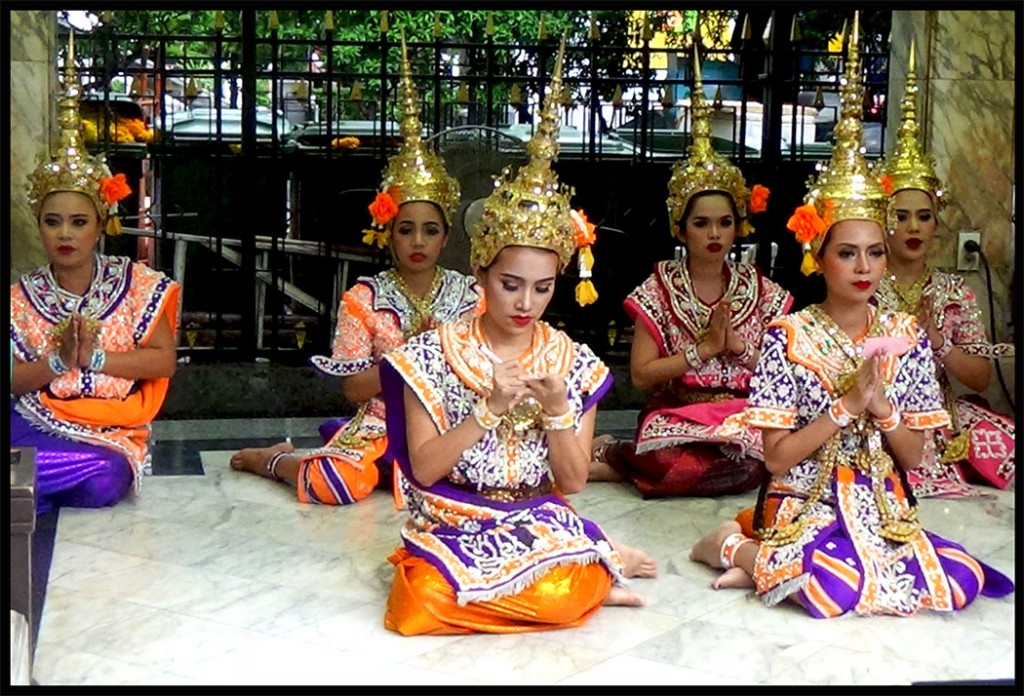
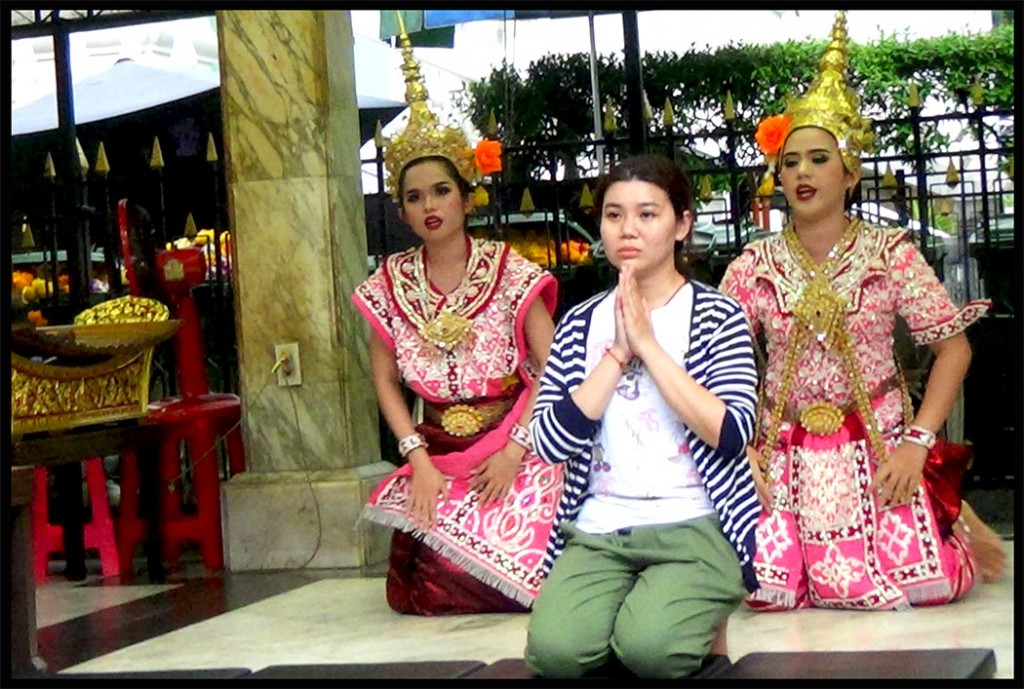


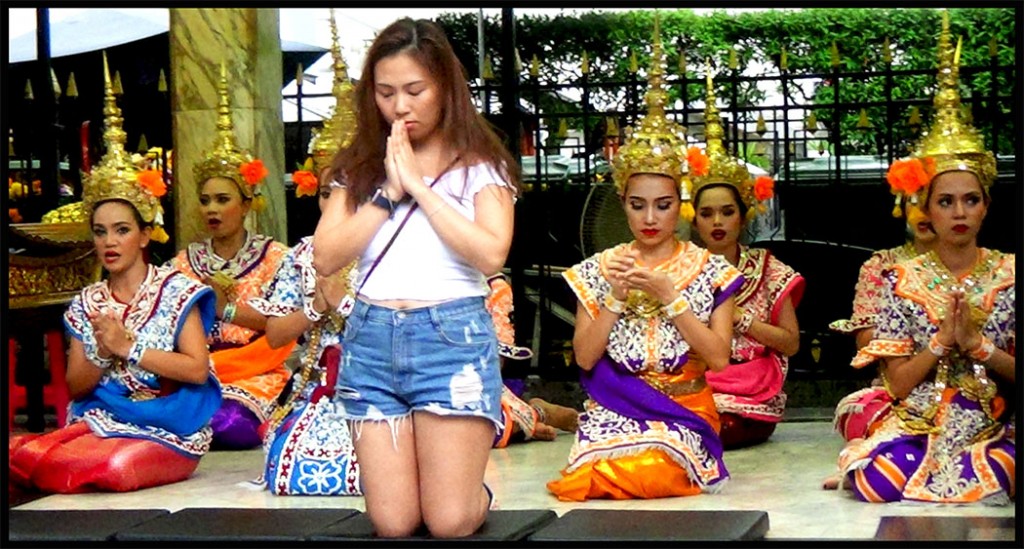
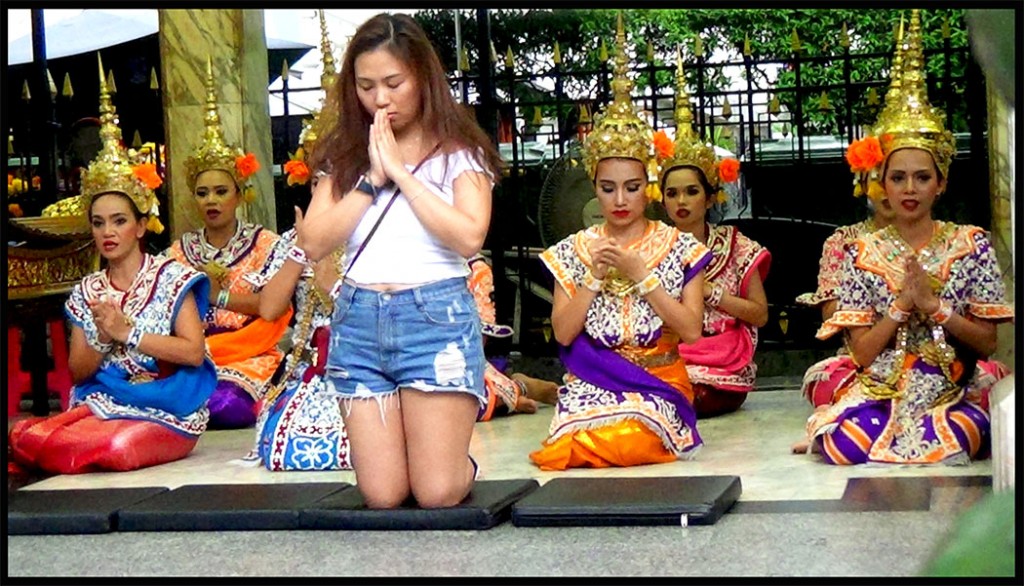

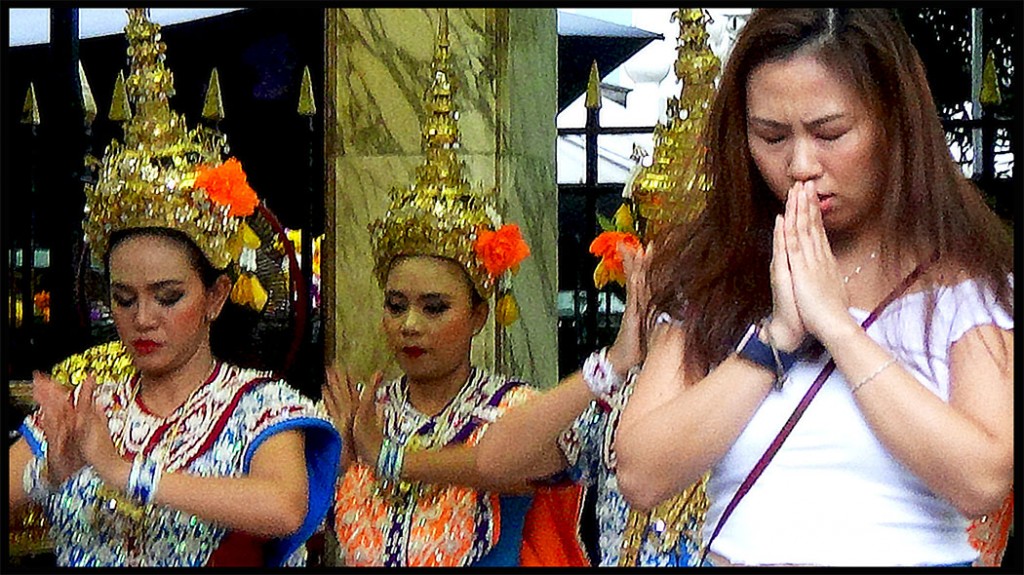
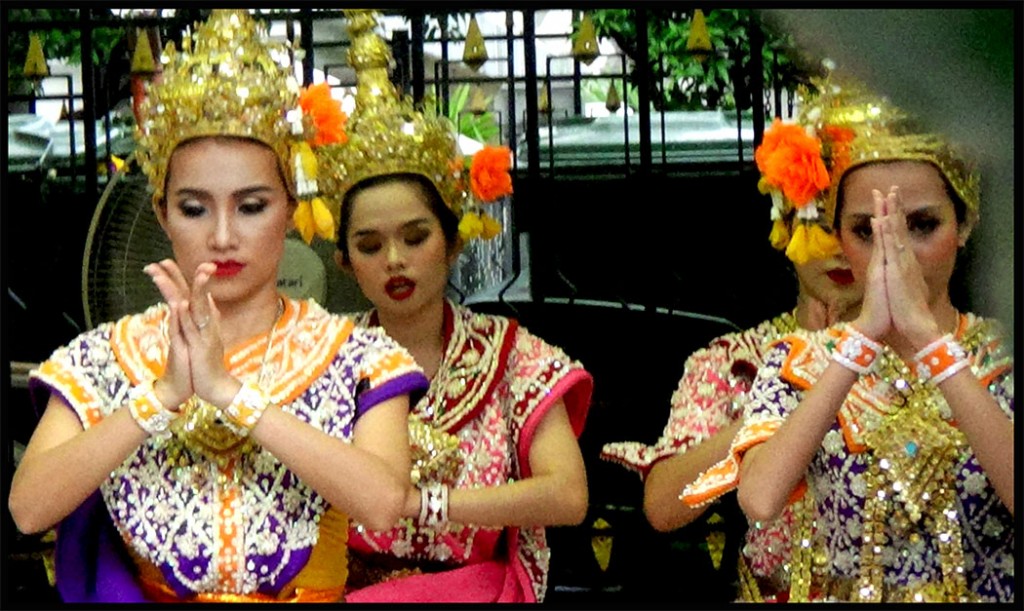
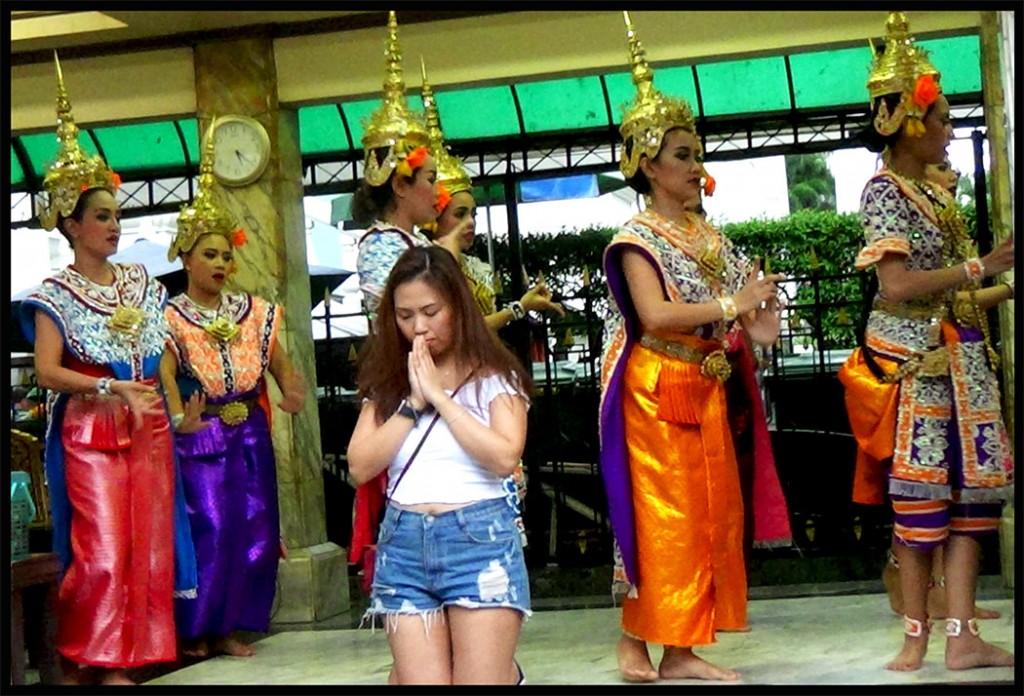
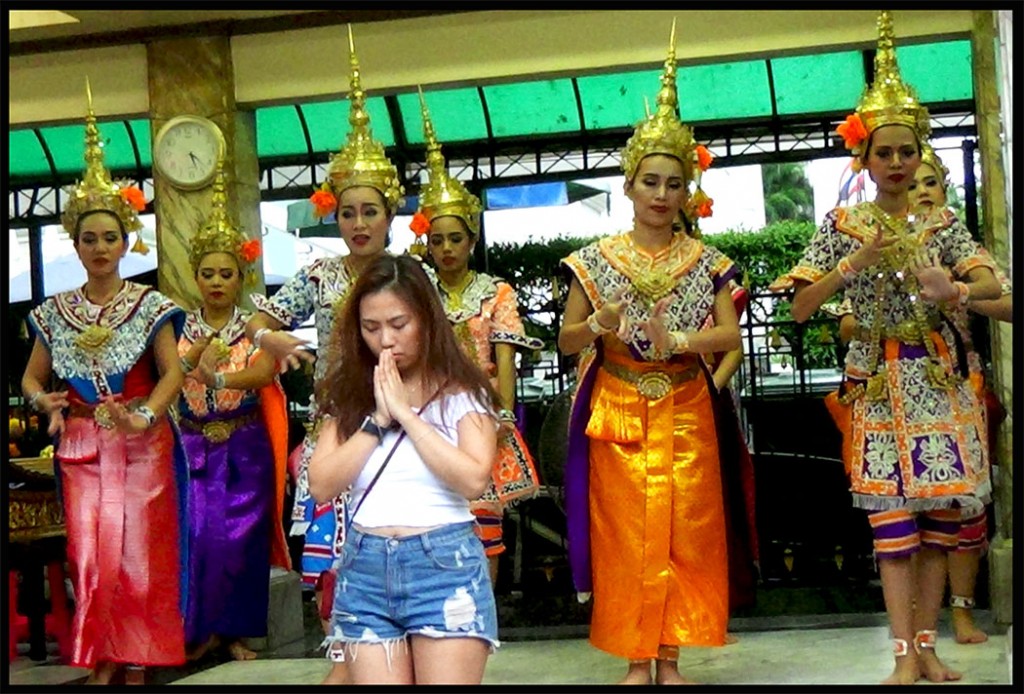
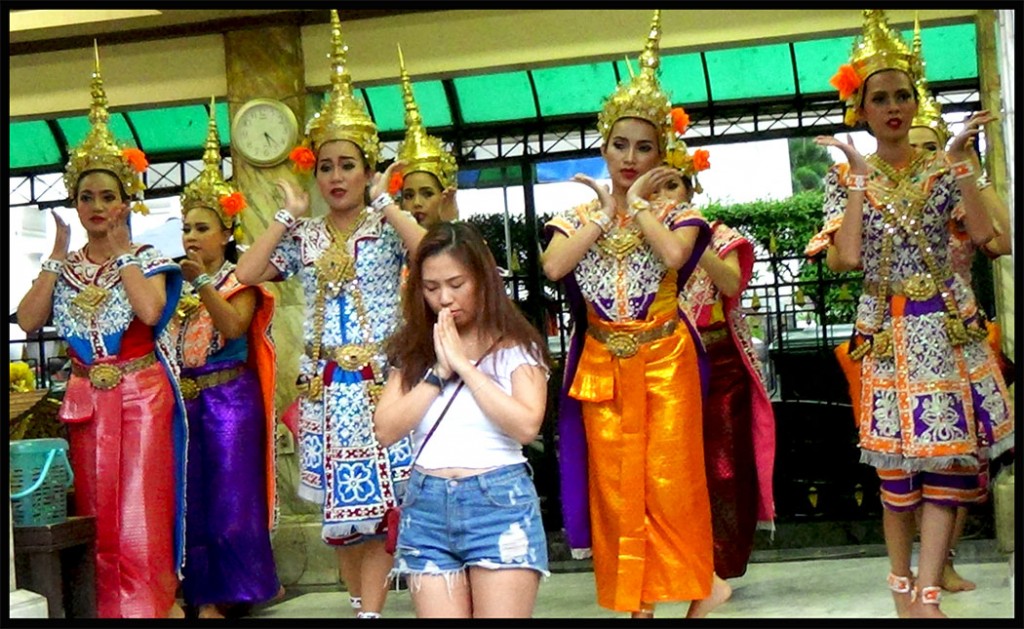
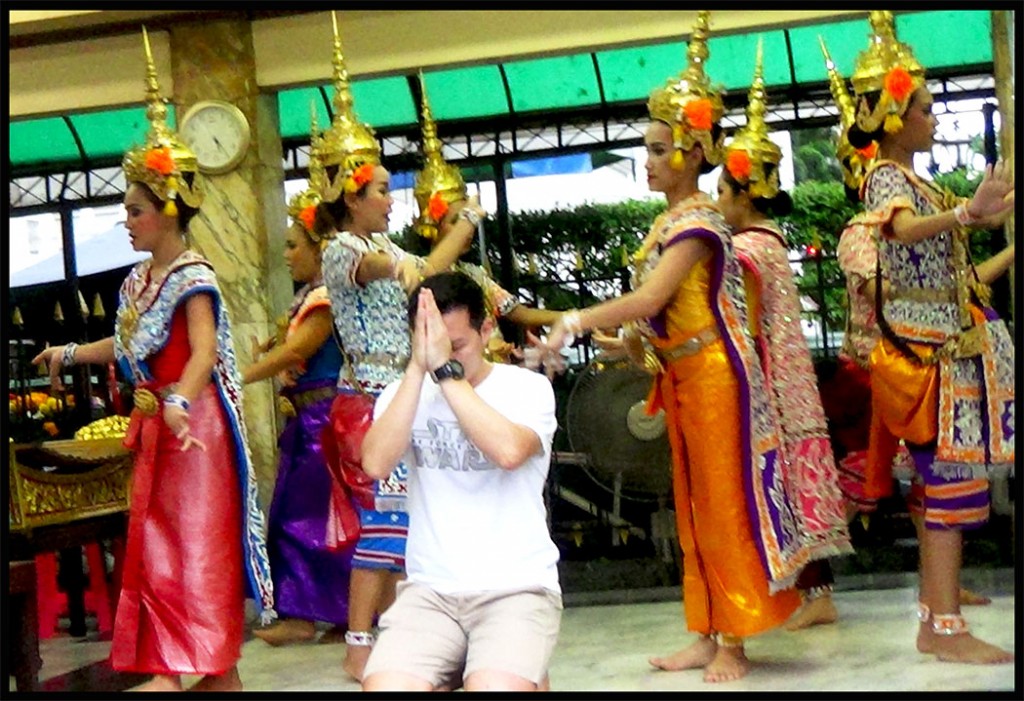
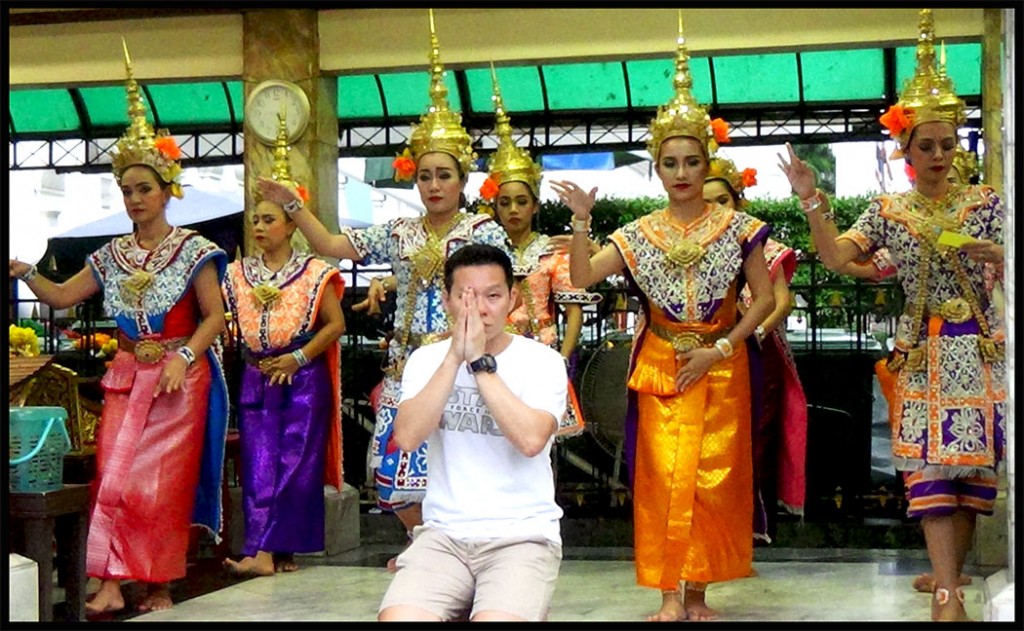
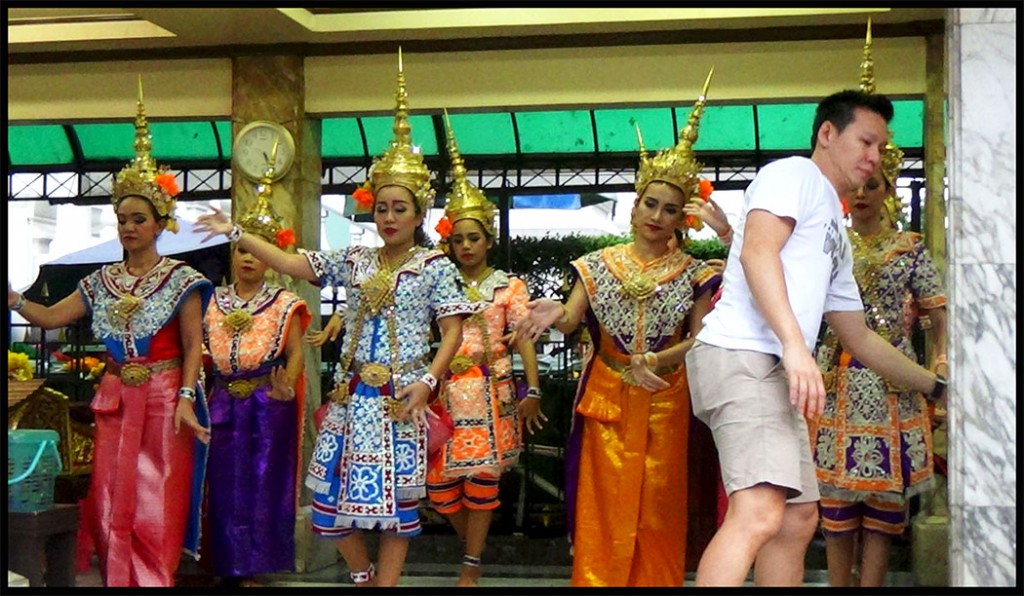
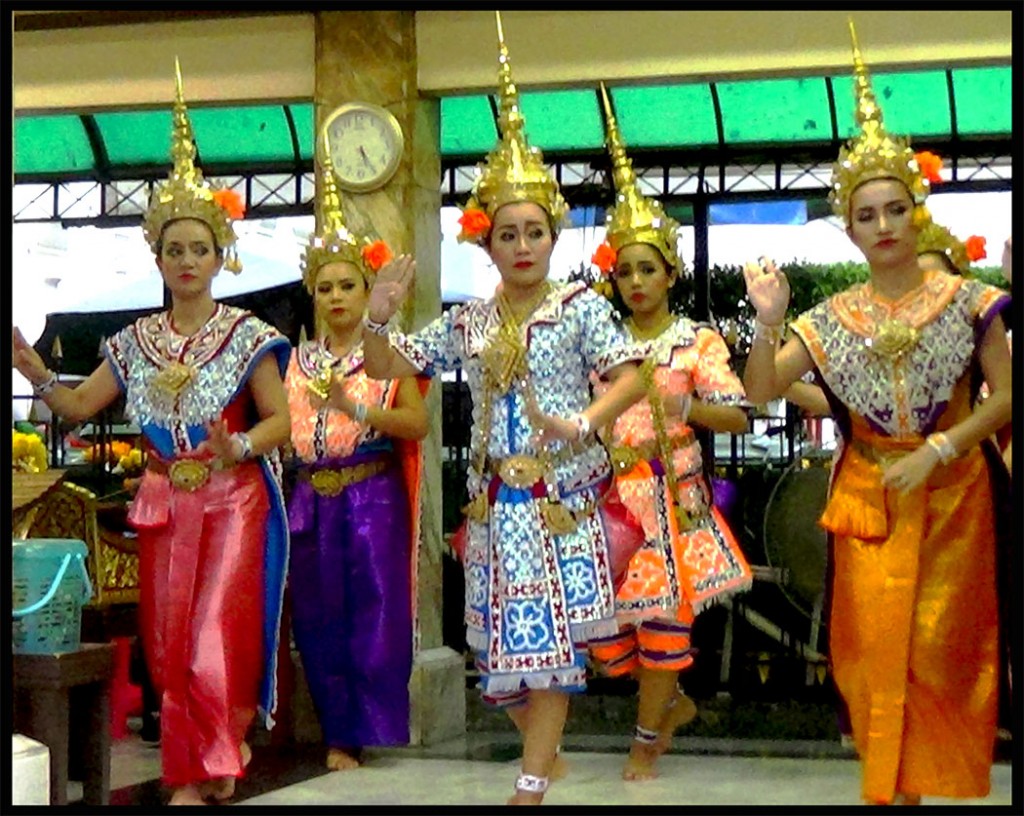
Leave a Reply